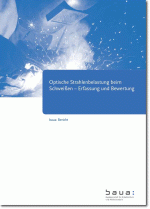Optical Radiation Exposure During Welding - Recording and Assessment
(in German)
The joining technology welding is the most common method used in industry for thermally joining two metals. A recent study shows that around 260000 German employees had to deal with welding in 2011. Thereby, the variety of different welding techniques ranges from resistance and arc welding to modern hybrid methods that use laser radiation. Despite the century-old development, there is still a steady progress within this field, for example, new cold welding techniques find their way into the in-plant daily routine.
The arc welding methods (aside of laser welding and plasma cutting) that are mainly investigated within this research report are accompanied by a high emission of optical radiation and thus connected to a high hazardous potential for welders and other employees. This finding is well known for a long time and has been documented extensively in the 1970s and 1980s. Unfortunately, in the following years, the interest in radiation protection during welding decreased so that due to technological progress today's data base is largely outdated. In addition, modern optical devices offer improved and more advanced possibilities of investigation as it was the case, for example, 30 years ago.
Main goal of this research project was a comprehensive update of the database of radiation emission during welding, on the one hand, to improve the optical radiation protection of welders, on the other hand, to be able to provide information for employers and security specialists to ensure a safe workplace.
This research report includes the results of the experimental measurements that were conducted under quasi laboratory conditions and that reveal the dependence of irradiance from basic welding parameters such as welding current and arc length. Thereby, the main interest focused on welding techniques and parameters used in practice.
It was found that the actinic exposure limit value is exceeded within a split second for high welding currents. Radiation hazards due to visible light, often referred to as Blue Light Hazard, have a high potential for eye damage whereas the portion of infrared radiation is lower but may not be neglected. Overall, welding techniques with a melting electrode are those with the highest radiation emission.
Finally, the mathematical fit models (irradiance as a function of welding current) that were achieved while analyzing the experimental data were validated in practice with regard to applicability.
Please download the complete report "Optical Radiation Exposure During Welding - Recording and Assessment" (in German only).
Bibliographic information
Title: Optische Strahlenbelastung beim Schweißen - Erfassung und Bewertung.
1. edition. Dortmund: Bundesanstalt für Arbeitsschutz und Arbeitsmedizin, 2017. pages: 146, Project number: F 2368, paper, PDF file, DOI: 10.21934/baua:bericht20170523
